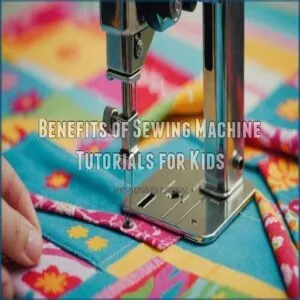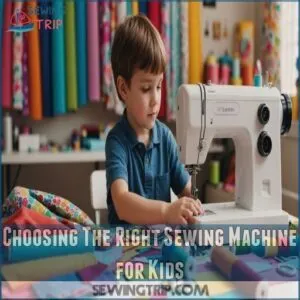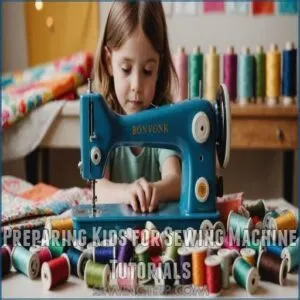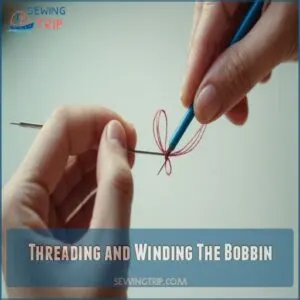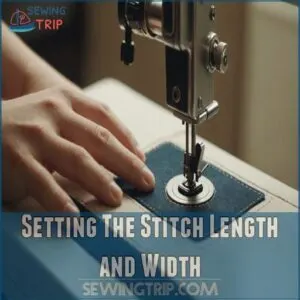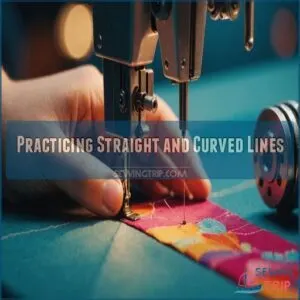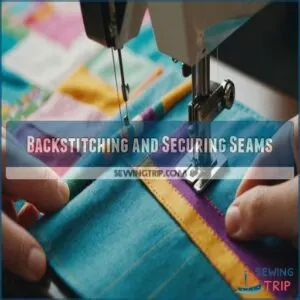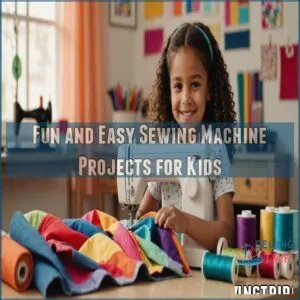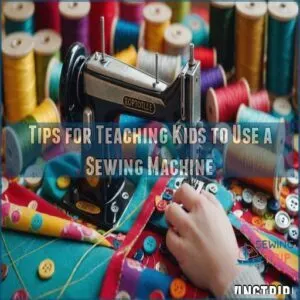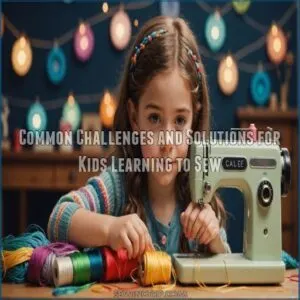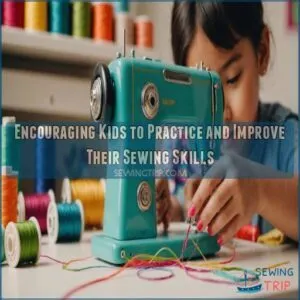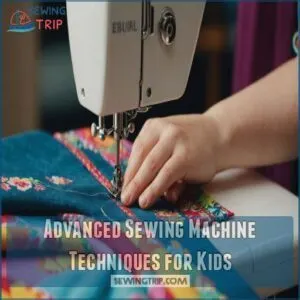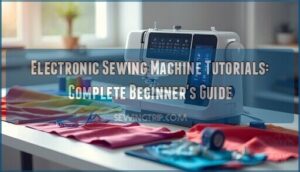This site is supported by our readers. We may earn a commission, at no cost to you, if you purchase through links.
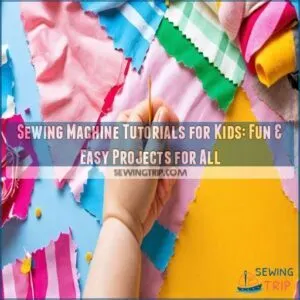 Sewing machine tutorials for kids are a fantastic way to spark creativity while boosting confidence!
Sewing machine tutorials for kids are a fantastic way to spark creativity while boosting confidence!
They don’t just make cool projects like pillowcases or tote bags; they also sharpen fine motor skills and hand-eye coordination.
Imagine your child mastering the art of threading a needle or sewing a straight line—it’s like magic in their hands!
When choosing a machine, remember safety features like needle guards are very important.
Start with simple concepts, then watch as they patiently sew their imagination into reality.
If that sounds exciting, there’s so much more these tutorials can offer in the journey of sewing mastery.
Table Of Contents
- Key Takeaways
- Benefits of Sewing Machine Tutorials for Kids
- Choosing The Right Sewing Machine for Kids
- Preparing Kids for Sewing Machine Tutorials
- Basic Sewing Machine Skills for Kids
- Fun and Easy Sewing Machine Projects for Kids
- Tips for Teaching Kids to Use a Sewing Machine
- Common Challenges and Solutions for Kids Learning to Sew
- Encouraging Kids to Practice and Improve Their Sewing Skills
- Advanced Sewing Machine Techniques for Kids
- Frequently Asked Questions (FAQs)
- Conclusion
Key Takeaways
- You’ll boost your child’s creativity and confidence through sewing machine tutorials, learning basic sewing techniques to make their own designs and projects, as they learn to make their own designs and projects.
- You can help them develop fine motor skills and hand-eye coordination, turning sewing into a fun and educational activity.
- Emphasize safety by choosing machines with features like needle guards and encourage patience as they tackle sewing challenges.
- Start with simple projects, gradually increasing complexity to keep them engaged and excited about learning new skills.
Benefits of Sewing Machine Tutorials for Kids
Teaching your child how to use a Singer sewing machine for kids can be a great way to introduce them to the world of sewing, offering a variety of kid-friendly models with features like automatic needle threaders and easy-to-use controls. Teaching your child how to use a sewing machine opens up a world of creativity and boosts their confidence, while also helping them develop fine motor skills and hand-eye coordination.
These tutorials encourage problem-solving and critical thinking, providing a fun way to foster patience and perseverance—traits you’ll appreciate both in sewing and in life!
Builds Confidence and Creativity
As you learn to sew, you’ll discover amazing things!
Sewing lets your imagination run wild.
You’ll design your own creations, solving problems along the way.
Each finished project boosts your confidence; it’s like opening up a superpower!
These sewing machine tutorials for kids aren’t just lessons; they’re a journey of self-expression and exploration.
You’ll be amazed at what you can create!
Sewing is a fantastic way to build skills and have fun.
Develops Fine Motor Skills and Hand-Eye Coordination
Think of sewing as a fun workout for your fingers.
When kids use a portable sewing machine for kids, they boost their fine motor skills and hand-eye coordination.
Juggling fabric and thread strengthens focus and dexterity.
Imagine threading needles or guiding fabric—each task hones precision.
These skills, taught through sewing lessons, can truly weave magic into everyday activities.
Enhances Problem-Solving and Critical Thinking
Mastering sewing machine basics isn’t just about nimble fingers.
It’s a virtual playground for the mind, bustling with troubleshooting and design thinking.
Picture your child puzzling over pattern interpretation, selecting the perfect fabric choice, or planning intricate projects.
These sewing tutorials, perfect for beginners, nurture critical thinking, allowing kids to tackle challenges and craft their imaginative ideas into tangible creations.
Fosters Patience and Perseverance
Tackling sewing challenges inevitably brings patience and perseverance to the forefront.
With every stitch, kids face a learning curve that requires focus and steady hands.
They’ll realize that even small successes in project completion take time management and dedication.
This journey with the sewing machine doesn’t just teach sewing techniques; it instills invaluable life skills like resilience and determination.
Choosing The Right Sewing Machine for Kids
Choosing the right sewing machine for your child is like finding the perfect pair of shoes; you want one that fits just right with their skills and needs.
Look for machines that balance safety, ease of use, and reliability, so your young sewing enthusiast can stitch confidently and joyfully.
Consider Age and Skill Level
Confidence and creativity thrive when kids start sewing, but selecting the right sewing machine can feel like threading a needle in the dark.
Focus on their age and skill level. Younger kids benefit from simple machines, sparking independence and skill progression. Older ones may tackle complex projects.
Match projects with sewing patterns to their learning pace for ultimate mastery.
Look for Safety Features and Ease of Use
Choosing a sewing machine for kids involves looking for safety features and ease of use.
Consider searching online marketplaces, such as those selling kids sewing machines, to find models that cater to your child’s needs.
You might want:
- Needle guards: Keep fingers safe from harm.
- Foot pedal control: Manage speed with ease.
- Automatic needle threader: Simplify threading.
- Lightweight design: Easy to handle and move.
- Child-friendly controls: Many sewing machines for kids, such as the Brother XM1010 model, have intuitive and simple features, making sewing machine safety a top priority.
Check for Durability and Reliability
So, you’ve found a kid-friendly sewing machine that’s easy to use and safe. Now, let’s talk durability!
Check the build quality – a sturdy machine will last longer.
Read user reviews; they often mention sewing machine lifespan and maintenance needs.
A good warranty and readily available support are also important.
Think of it like this: you want a sewing machine that can handle years of creative sewing projects!
Consider The Price and Brand Reputation
You’ve got durability checked off; now, let’s chat about price and brand reputation.
Balancing price vs. quality matters—nobody wants a wallet-emptying machine.
Consider budget-friendly options that offer value for money, making them long-term investments.
Stick with reputable sewing machine brands known for reliable needles, threads, feet, and bobbins, building brand loyalty over time.
Happy sewing!
Preparing Kids for Sewing Machine Tutorials
Getting kids ready for sewing machine tutorials starts with introducing basic sewing concepts and practicing simple hand-sewing projects.
As you guide them through these steps, emphasize safety and properly handling the machine parts, turning a potential tangle of threads into a rewarding creative journey.
Start With Basic Sewing Concepts
Imagine a world where sewing isn’t just for grown-ups.
Jump-start kids’ journey by introducing basic sewing concepts.
Explain sewing machine basics, needle and fabric types, stitch techniques, and essential sewing tools.
Discuss sewing machine tension and stitching.
It’s like giving them a magic wand to create!
This foundation helps them get started with sewing with confidence and curiosity.
Practice With Hand-Sewing and Simple Projects
Let’s get started with hand-sewing basics with simple stitch practice.
Encourage your child to explore fabric manipulation by choosing fun fabrics and beginner tools.
Practice dot to dot sewing using sewing worksheets designed for toddlers and preschoolers.
Project ideas, like making a small pillow, can ignite creativity and provide a fulfilling, hands-on experience in sewing for children.
Introduce Sewing Machine Parts and Functions
When you first introduce kids to a sewing machine, start by showing the sewing machine parts and functions.
Chat about sewing machine basics like needle types and bobbin winding.
Knowing these elements helps kids feel in control and sparks their curiosity for more.
Consider investing in a sewing machine specifically designed for girls, such as those available on Sewing Machines for Girls, to make their learning experience more enjoyable.
Using everyday examples, guide them through foot types and stitch selection to boost beginner sewing enthusiasm.
Emphasize Safety and Proper Handling
Follow safety rules like a seasoned pro!
Before diving into sewing projects for kids, it’s essential to have a basic sewing kit that includes fabric scissors and sewing needles to ensure they have the necessary tools to get started, and then highlight needle safety and machine operation.
Keep fingers out of harm’s way by using finger protection.
It’s like giving mini sewing superheroes their capes!
So, engage them with sewing crafts for kids, turning each stitch into a step toward creative freedom and fun.
Basic Sewing Machine Skills for Kids
Ready to become a sewing machine whiz? We’ll start with the basics—threading, stitch settings, and making those perfect straight lines, so you can create amazing things!
Threading and Winding The Bobbin
Threading and winding the bobbin, a fundamental skill for young sewers using ThreadCrate Kids Kits, is like threading happiness into every sewing project.
You’ll start by choosing the right bobbin size for your sewing machine, ensuring the bobbin tension is just right.
Place it in the bobbin case, then practice with different thread types.
It’s a small step but essential, just like understanding thread types in a sewing class adventure!
Setting The Stitch Length and Width
Setting the stitch length and width is a breeze and essential for your sewing success.
Imagine your stitch as the rhythm of your machine.
Adjusting lengths impacts fabric type and seam strength, while width control fine-tunes stitch types.
Faster sewing machine speed can alter your design, so feel free to experiment with different patterns for perfect sewing machine fabric results!
Practicing Straight and Curved Lines
Diving into sewing, straight and curved lines become your canvas.
Picture them as the basic strokes of a painting—essential yet transformative.
Practice tools and sewing games can make this learning journey fun.
Experiment with line variations to explore your style, and don’t worry about common mistakes; they’re part of the creative process.
Embrace these design ideas with excitement!
Backstitching and Securing Seams
Feeling confident with straight lines? Let’s tackle backstitching to secure those seams.
It’s a nifty trick for stronger stitches whether it’s machine or hand sewing.
Here’s how:
- Start a few stitches ahead and reverse.
- Go forward over them to lock.
- Troubleshoot if seams unravel.
Make each stitch count! Perfect for sewing projects for toddlers through teens.
Fun and Easy Sewing Machine Projects for Kids
You can boost your child’s creativity and confidence with fun, easy sewing machine projects that are perfect for beginners.
From creating simple pillowcases to crafting adorable stuffed animals, these projects are engaging and rewarding.
Making sewing a delightful journey for young makers.
Making a Simple Pillowcase or Tote Bag
You’ve mastered basic sewing skills, so let’s create something fun!
A pillowcase or tote bag is an easy sewing project perfect for beginners.
You can find many more ideas and inspiration in simple tote bag patterns.
Choose cheerful fabric and set your sewing machine for straight lines.
Consider embellishment ideas like patches or trim.
Don’t worry about perfection—explore project variations with your unique touch.
Troubleshooting tips? Practice makes perfect!
Creating a Quilt or Patchwork Design
Creating a quilt is easier than you think!
It’s a fantastic sewing project for families.
Start by selecting fun fabrics.
Then, learn basic piecing techniques to create quilt blocks.
- Choose simple quilt blocks.
- Practice sewing straight seams.
- Add your own creative quilting styles!
Sewing a Stuffed Animal or Doll Clothes
Imagine your child’s eyes lighting up when they create their own stuffed animal or doll clothes.
These projects offer a unique way to use sewing tools and try out fabric choices and embellishments.
Find simple stuffed animal patterns or explore various doll clothes styles.
Encourage them to express creativity with sewing ornaments and develop new skills with adorable sewing project ideas.
Making a Zipper Pouch or Coin Purse
Turning a child’s creative spark into a zipper pouch is a breeze with the right steps.
Start by picking favorite fabrics and learning about different zipper types.
You might even want to check out a beginner sewing kit to get all the supplies you need.
Experiment with design ideas to make each pouch unique.
Don’t forget sewing tips for smooth seams.
These fun sewing ideas inspire a lifelong sewing machine hobby, making practical sewing gifts or decorations.
Tips for Teaching Kids to Use a Sewing Machine
Teaching kids to use a sewing machine can be a rewarding experience if you start simple and show plenty of patience.
Clear instructions and demonstrations will help them stitch with confidence and turn any little mishaps into fun learning moments.
Start With Simple Projects and Gradually Increase Complexity
Starting with simple projects is like handing the keys to creativity: start with a three-seam pillowcase or a cozy toy sleeping bag.
Keep in mind that kids develop fine motor skills and coordination at an ideal age range of 6-9 years old, which is essential for mastering Tips For Teaching Kids To Sew.
As skills progress, introduce more complex ideas, like sewing a garment or a piece of art.
This gradual mastery helps young sewists tackle each learning curve with confidence while keeping it age-appropriate and fun.
Provide Clear Instructions and Demonstrations
Once you’ve chosen simple projects, explaining each step clearly is essential.
Use visual aids and step-by-step guides to make sewing easy to grasp.
Sprinkle in practice drills with real-time feedback to keep them engaged and learning.
- Use visuals to explain concepts.
- Break tasks into simple steps.
- Share tips with interactive lessons.
- Make it fun with sewing headbands and more.
Encourage Practice and Patience
You’ve nailed the demos; now, let’s embrace the quirks of sewing.
Encourage kids by setting achievable goals and celebrating small wins.
Praise their patience as they stitch toward sewing school dreams and maze sewing triumphs.
With each project, they’ll fashion newfound skills, building independence.
Embrace mistakes as learning moments—first drafts, not failures.
Stay patient and cheer them on!
Common Challenges and Solutions for Kids Learning to Sew
Learning to sew can be tricky sometimes—even frustrating!
But don’t worry, we’ll cover common problems like threading the machine or getting the right stitch length, and show you how to fix them easily,
so you can keep creating awesome projects.
Trouble Threading The Machine or Winding The Bobbin
Threading machines or winding bobbins can seem tricky, but fear not.
With a bit of practice, you’ll tackle these challenges like a pro.
Here are some tips:
- Follow your machine’s manual.
- Watch online videos for visual guidance.
- Use well-lit areas to see details better.
- Keep thread tension steady.
- Practice needle threading often.
Difficulty With Tension or Stitch Length
Tension troubles or stitch length woes can stump any budding sewer. It’s like your machine’s playing tricks! Often, it’s caused by incorrect threading or bobbin placement.
To fix tension, check guides and adjust the dial gently.
For stitch length issues, make sure settings match your fabric type.
Remember, even pros face this—it’s part of sewing’s charm and mastery journey!
Problems With Fabric Feed or Seam Allowance
Finding it tricky to adjust the tension was just the beginning.
Now, let’s explore fabric problems.
Imagine these steps:
- Fabric Slipping: Check if the presser foot is down.
- Uneven Feed: Use a walking foot if needed.
- Seam Puckering: Loosen tension slightly.
- Fabric Bunching: Make sure you’re sewing slowly and steadily.
Nurture patience; mastery follows!
Frustration With Mistakes or Unraveling
While seam allowances can trip kids up, mistakes or unraveling might challenge their patience.
Remind them that even seasoned pros pull out the seam ripper now and then.
Encourage practice with bits of humor and positive reinforcement, turning these hiccups into stepping stones.
Let them know that each error brings them closer to sewing mastery!
Encouraging Kids to Practice and Improve Their Sewing Skills
You can help kids practice their sewing skills by setting realistic goals, offering opportunities for creative fun, and celebrating each stitch of progress.
Encourage them with positive feedback, and soon you’ll be amazed at how quickly they’ll improve and enjoy the process!
Setting Realistic Goals and Expectations
Instead of jumping into a complex quilt, aim for age-appropriate projects suited to your child’s skill level.
That way, you’re setting them up for success.
Keep projects short to match their attention spans.
Think of it like a sewing snack—not an all-day feast!
This approach helps manage time commitments and keeps them excited about diving back into the feedback loop.
Providing Positive Feedback and Encouragement
Let’s get those sewing skills humming!
Remember, progress, not perfection, is key.
Celebrate even the smallest wins—that crooked stitch? It’s a learning curve!
Here’s how to help:
- Celebrate successes: High-five those accomplishments!
- Avoid criticism: Focus on effort, not mistakes.
- Focus on effort: "Wow, you’re really concentrating!"
- Build confidence: Offer support and encouragement; you got this!
Offering Opportunities for Creative Expression
Encourage your child’s imagination by letting them choose their own fabric choices and create unique designs.
Personalized styles are a fantastic way to reflect their personality.
Suggest project variations, like crafting expressive details on a purse or pillow.
These activities help kids practice and improve their sewing skills, making sewing both a creative and educational adventure.
Celebrating Progress and Achievements
Watching your kids revel in their sewing milestones is like seeing their artwork come to life.
Share these successes with friends and family, emphasizing skill growth.
Consider awards or fun rewards for each achievement.
It’s about discovering joy in their progress, so celebrate their creations with pride.
After all, every stitch marks a step forward!
Advanced Sewing Machine Techniques for Kids
You’ve mastered the basics, so now it’s time to tackle more advanced sewing machine techniques like adding zippers and buttons.
Don’t worry if it seems tricky at first; with practice, you’ll be creating closures and fasteners like a pro, transforming your projects into polished masterpieces.
Working With Zippers and Buttons
Ever tried working with zippers and buttons? It’s like a gateway to endless creative projects!
You’ll explore 1. Zipper types for different needs.
2. Button placement to enhance style.
3. Sewing buttonholes with precision for a snug fit, and 4. Zipper troubleshooting to tackle unexpected hiccups.
Mastering these skills brings freedom to tackle more complex designs.
Creating Closures and Fasteners
Let’s explore sewing closures, a nifty skill that opens up creative possibilities, including mastering the perfect hook and eye closures.
From zipper techniques to buttonholes, you’ll master the art of fasteners.
Imagine the satisfaction of perfectly stitched or a snug hook and loop on your project.
With practice, these sewing closures won’t feel like rocket science, but rather a fun puzzle you’re solving!
Frequently Asked Questions (FAQs)
How do you teach a child to sew?
Imagine a child’s face lighting up with discovery!
Start simple with hand-sewing projects, use practice sheets, and be patient.
Guide them step-by-step, encourage creativity, and celebrate small wins.
Mistakes? They’re just stepping stones to mastery!
What are some easy DIY sewing projects for kids?
When introducing kids to sewing, it’s essential to spark their interest in sewing. Jump into fun sewing projects with your kids like scrunchies, star pillows, or soft toys.
These activities spark creativity and teach valuable skills, turning simple fabrics into delightful treasures they’ll be proud of.
Happy sewing!
How do you teach a student to sew a project?
Start by choosing a simple project and gathering materials.
Encourage hands-on practice, explaining each step clearly.
Allow mistakes and celebrate progress.
Use visuals or examples for guidance, and keep it fun to boost confidence and creativity.
What are the best hand sewing projects for kids?
Hand sewing’s like a playful puzzle kids love solving!
Try crafting cute star pillows, soft toys, or colorful scrunchies.
These projects are simple, teach essential skills, and spark creativity.
Kids can’t resist making something uniquely theirs!
How to teach a 7 year old to use a sewing machine?
It’s awesome you’re teaching your 7-year-old to sew! Start with simple projects and a child-sized machine. Supervise closely, emphasizing safety first. Celebrate their creations – it’ll boost their confidence!
At what age should you teach a child to sew?
Teaching a child to sew is like teaching them to ride a bike—perfect timing matters.
Start with simple hand-sewing projects around ages 5-7 to spark creativity.
By age 9, introduce machine sewing with guidance.
What is the easiest thing to sew for kids?
Try starting with cloth napkins as the easiest sewing project for kids.
They’re simple, don’t require a ton of fabric, and kids will love using their creations at mealtime—it’s a fun way to learn sewing basics!
What can I make with a sewing machine for kids?
With a sewing machine for kids, explore creating simple projects like scrunchies, star pillows, or fun doll clothes.
These projects boost confidence, encourage creativity, and make sewing a playful, rewarding experience for young hands.
What safety tips for kids using machines?
Picture a dance floor, where every move counts.
Supervision is key.
Keep fingers clear of the needle.
Use slow speeds.
Teach kids to unplug machines when not in use—safety spins every step!
How often should kids practice sewing?
Kids should practice sewing regularly, like once or twice a week, to gradually build skills.
Consistent practice makes sewing feel like second nature, so encourage fun projects and celebrate successes to keep their interest alive!
What age to start sewing machine lessons?
Starting sewing machine lessons around age 8 is a sweet spot, as kids have better coordination and patience.
Make it fun, keep things light, and soon they’ll enjoy crafting everything from cute plushies to colorful quilts!
Are there online sewing communities for kids?
Want to connect with fellow young sewists? You’ll find tons of online groups! Search for "kids sewing forums" or "youth sewing communities" – you’ll discover a supportive network of crafty kids.
How to keep kids engaged in sewing?
Encourage their creativity by picking fun, quick projects like scrunchies or doll clothes they can use.
Let them choose fabrics and colors, giving them ownership.
Celebrate their successes with high-fives, making sewing a joyful adventure together!
Conclusion
Ready to inspire creativity in your kids?
Sewing machine tutorials for kids are the perfect way to teach new skills while having fun.
You’ll help them build confidence and patience as they learn to make useful projects and tackle challenges.
Whether it’s a simple tote bag or a stuffed animal, these tutorials open up a world of possibilities.
Get started today and watch as your child stitches their way to creativity and self-expression!

